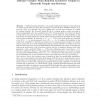Free Online Productivity Tools
i2Speak
i2Symbol
i2OCR
iTex2Img
iWeb2Print
iWeb2Shot
i2Type
iPdf2Split
iPdf2Merge
i2Bopomofo
i2Arabic
i2Style
i2Image
i2PDF
iLatex2Rtf
Sci2ools
143
click to vote
DIALM
2008
ACM
2008
ACM
Distance graphs: from random geometric graphs to Bernoulli graphs and between
A random geometric graph G(n, r) is a graph resulting from placing n points uniformly at random on the unit area disk, and connecting two points iff their Euclidean distance is at most the radius r(n). Recently, this class of graphs have received much attention as a model for wireless networks. The Bernoulli graph B(n, p) is a random graph in which each edge is chosen independently with edge probability p(n). The critical parameter for connectivity played a major role in the study of both G(n, r) and B(n, p), and in what may seem surprising, it has been shown that both graphs have closely related critical connectivity thresholds for the radius and the edge probability. In particular, if r2 = p = log n+n n then both graphs are connected w.h.p. iff n + and disconnected w.h.p. iff n -. To explain the similarities in the connectivity thresholds, we introduce an extension of the random geometric graphs: the random distance graph, D(n, g): A graph resulting from placing n points uniformly ...
Related Content
| Added | 19 Oct 2010 |
| Updated | 19 Oct 2010 |
| Type | Conference |
| Year | 2008 |
| Where | DIALM |
| Authors | Chen Avin |
Comments (0)

